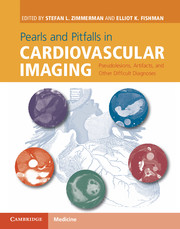 Pearls and Pitfalls in Cardiovascular Imaging
Pearls and Pitfalls in Cardiovascular Imaging from Section 4 - Coronary arteries
Published online by Cambridge University Press: 05 June 2015
Imaging description
When incidentally detected on radiography, saphenous vein graft aneurysms most commonly present as mediastinal masses (Figure 40.1). This leads to follow-up cross-sectional imaging to narrow the broad differential diagnosis, which will more clearly characterize the “mass” as a large aneurysm (Figure 40.2). Vein graft aneurysms can easily grow to 6 cm or more in greatest diameter, and may be filled with a large amount of thrombus. It is important to identify whether the native coronary artery distal to the aneurysm is patent (Figure 40.3), because this will dictate treatment options (e.g., closure or embolization vs. endovascular stenting).
Importance
Saphenous vein graft aneurysms are an uncommon complication of coronary artery bypass grafting (CABG), thought to occur in less than 1% of patients. However, because of the increased risk of rupture, they are associated with significant morbidity and mortality. If the thrombus within the aneurysm sac is unstable, there is also an increased risk of myocardial infarction in the territory distal to the graft. In addition, as the aneurysm grows, it can exert a mass effect on adjacent structures, such as cardiac chambers or the pulmonary veins, resulting in heart failure.
If the graft and native vessel remain patent, percutaneous repair with a covered stent is the preferred therapy to preserve perfusion. However, if the graft is thrombosed, the aneurysm can be occluded using coil embolization or a closure device. In some cases, such as when the luminal diameter of the coronary arteries is too small to permit passage of the percutaneous repair apparatus, patients may undergo surgical repair involving resection of the aneurysm and replacement of the vein graft.
Typical clinical scenario
Saphenous vein grafts are often used for CABG. In rare cases, aneurysms of the vein grafts can form (as much as a decade or longer after the procedure) due to aggressive atherosclerosis. Such aneurysms are often incidentally detected during follow- up imaging or chest radiography for unrelated reasons.
To save this book to your Kindle, first ensure no-reply@cambridge.org is added to your Approved Personal Document E-mail List under your Personal Document Settings on the Manage Your Content and Devices page of your Amazon account. Then enter the ‘name’ part of your Kindle email address below. Find out more about saving to your Kindle.
Note you can select to save to either the @free.kindle.com or @kindle.com variations. ‘@free.kindle.com’ emails are free but can only be saved to your device when it is connected to wi-fi. ‘@kindle.com’ emails can be delivered even when you are not connected to wi-fi, but note that service fees apply.
Find out more about the Kindle Personal Document Service.
To save content items to your account, please confirm that you agree to abide by our usage policies. If this is the first time you use this feature, you will be asked to authorise Cambridge Core to connect with your account. Find out more about saving content to Dropbox.
To save content items to your account, please confirm that you agree to abide by our usage policies. If this is the first time you use this feature, you will be asked to authorise Cambridge Core to connect with your account. Find out more about saving content to Google Drive.